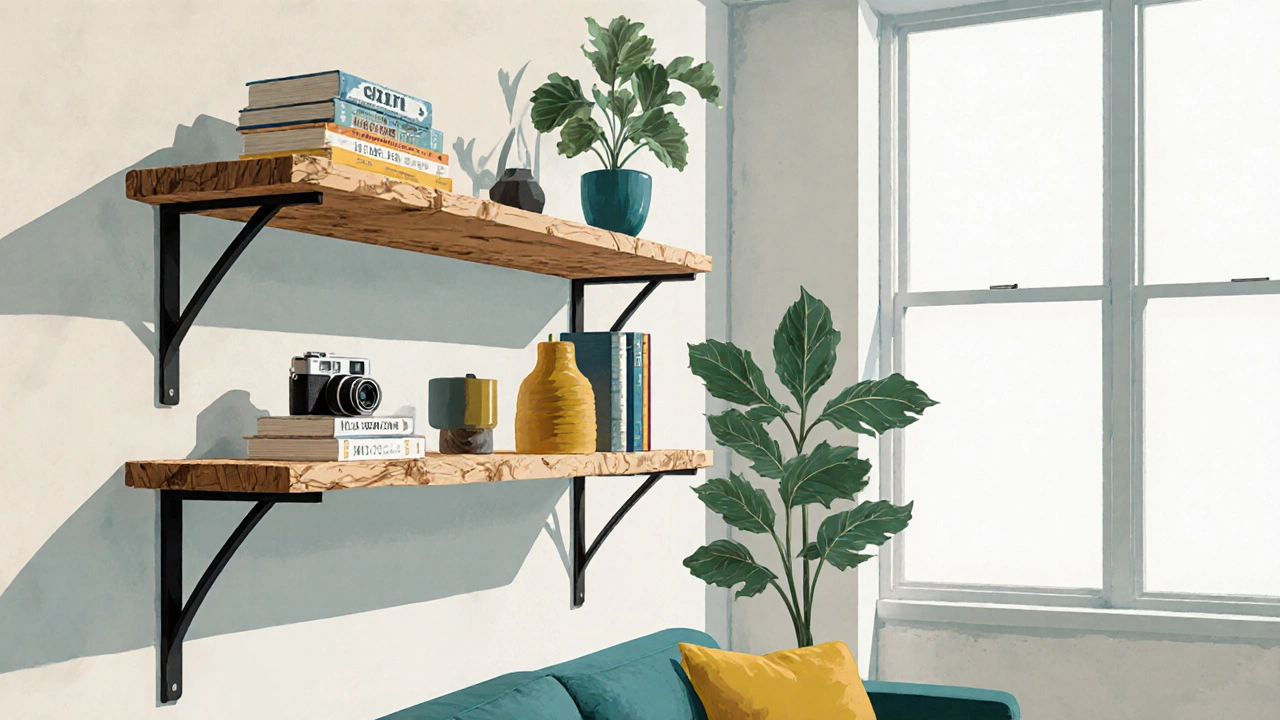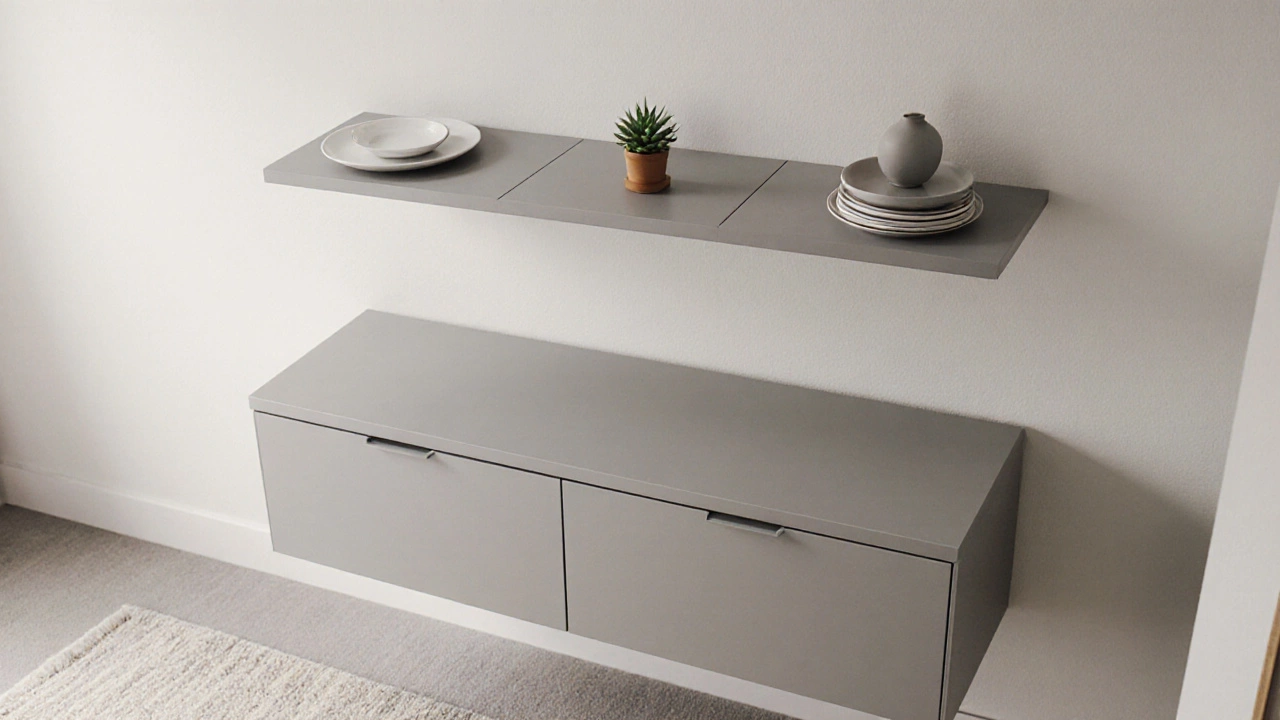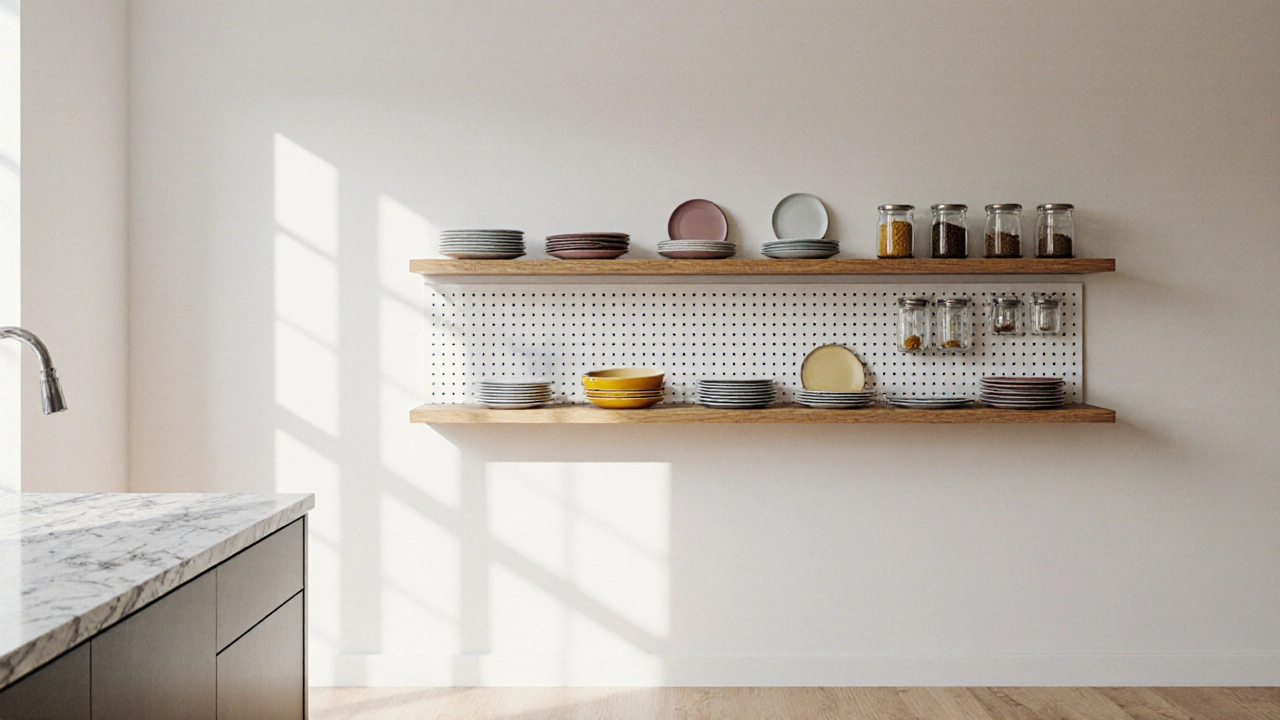Open Shelving Weight Calculator
Calculate Safe Weight Capacity
Determine the maximum safe weight for your open shelving based on bracket type, dimensions, and materials
Weight Capacity Results
Pro Tip: For safety, always leave a 20-30% buffer. Don't load shelves to their maximum capacity. Place heavier items closer to the wall and lighter items toward the front.
Every time you stroll through a design magazine or scroll Instagram, the glossy photos of airy kitchens and sleek living rooms showcase rows of visible plates, books, and decorative objects. It begs the question: is open shelving just the latest Instagram fad, or does it have staying power beyond the scroll?
What exactly is open shelving?
Open Shelving is a storage solution that leaves the back and sides of a shelf exposed, allowing items to be seen at a glance. Unlike traditional cabinets, there are no doors or drawers to hide the contents. The design relies on brackets, floating panels, or built‑in wall structures to support the shelf surface. The appeal is its visual openness - you can display dishes, plants, or books without the visual barrier of a closed door.
How did the trend start?
The concept isn’t new. Floating Shelves appeared in mid‑century modern homes of the 1950s, championed by designers like Finn Juhl and Charles and Ray Eames. They wanted an “uncluttered” look that emphasised form over function.
Fast forward to the 2010s, social media amplified the aesthetic. Platforms rewarded bright, minimalist spaces, and open shelving offered a ready‑made backdrop for perfect photos. By 2020, many retailers were launching entire collections labelled “Open Shelf Series.”
Why people love the look
Several design philosophies reinforce the appeal:
- Minimalist Design values clean lines and visual simplicity. Removing doors reduces visual clutter.
- Industrial Style often features raw metal brackets and reclaimed wood shelves, making the hardware a decorative feature.
- Scandinavian Interior emphasises natural light and airy spaces, where open shelves keep the room feeling light.
All three styles thrive on the idea that what you own should be visible, curated, and part of the decor rather than hidden away.
The practical side: pros and cons
Pros
- Instant visual access - you can grab a plate or a favorite novel without searching.
- Creates the illusion of larger space; the lack of bulkier cabinet doors lets the eye travel further.
- Customisable hardware - metal brackets, wooden cleats, or glass supports become design statements.
- Easy to install in most DIY‑friendly homes; usually a few brackets and a level are enough.
Cons
- Dust accumulates quickly - every item is exposed, so maintenance is more frequent.
- Clutter becomes obvious; a mis‑arranged shelf can look chaotic.
- Weight limits - over‑loading can warp the shelf or stress the brackets.
- Not ideal for items that need protection from sunlight or humidity.

When does open shelving become timeless?
It stops being a fad when it aligns with broader lifestyle principles rather than a visual trend. If you practice Home Organization habits - keeping items sorted, rotating seasonal pieces, and routinely dusting - open shelving can serve you for years.
Homes that adopt a consistent aesthetic, such as a Scandinavian or industrial palette, often keep open shelves as a core element. In contrast, a purely decorative, “show‑off” approach that changes monthly is more prone to feeling dated.
How to make open shelving work for you
Here are practical steps that turn the open‑shelf look from risky to reliable:
- Start with a purpose. Decide if the shelf will store everyday items (plates, mugs) or act as a display (art, plants). Function drives spacing and load capacity.
- Choose the right material. Oak or walnut give warmth; powder‑coated metal offers an industrial edge; glass adds a modern feel but can show fingerprints.
- Mind the depth. For kitchen backsplashes, 12‑16inches works for plates; deeper shelves (18‑24in) are better for books or larger décor.
- Invest in sturdy brackets. Heavy‑duty Metal Brackets can hold 30kg per pair, while decorative wooden cleats spread weight across the wall.
- Plan a colour scheme. Keep the shelf surface neutral (white, light wood) and use the displayed items for colour pops.
- Apply a “two‑item rule.” Whenever you add a new decorative piece, remove two older ones. This keeps the shelf from becoming cluttered.
- Use protective backs. A thin sheet of acrylic or pegboard behind plates prevents items from slipping and adds visual depth.
Cost and maintenance comparison
| Feature | Open Shelving | Closed Cabinets | Modular Storage Units |
|---|---|---|---|
| Initial cost (UK) | £30‑£150 per shelf | £200‑£800 per unit | £150‑£600 per system |
| Installation effort | DIY (30‑60min) | Professional fit‑out (2‑4hrs) | DIY assembly (1‑2hrs) |
| Maintenance | Weekly dusting | Monthly cleaning of doors | Occasional re‑configuration |
| Visibility | 100% | 0% (items hidden) | 50‑70% (partial) |
| Load capacity | Up to 30kg per shelf (depends on brackets) | Up to 50kg per cabinet | Variable - often 40kg per unit |
The table shows that open shelving is the most affordable entry, but you pay with higher upkeep. If you need to hide clutter or protect fragile items, a hybrid approach - a few closed cabinets paired with open shelves - offers the best of both worlds.

Alternatives to consider
If the idea of constantly dusting feels daunting, explore these options:
- Sliding doors. They give the visual lightness of a shelf but conceal the interior when closed.
- Glass-front cabinets. They preserve the airy feel while offering a dust barrier.
- Modular cube systems. You can mix open and closed cubes in the same unit, adapting as needs change.
Each alternative keeps the space feeling contemporary while addressing the practical drawbacks of fully exposed storage.
Real‑world examples
Kitchen. In a bright UK terraced house, a row of 12‑inch oak shelves sits above the countertop, holding everyday plates. The homeowner groups plates by colour, replaces the backs with a white pegboard for spice jars, and wipes down the surface nightly.
Living room. A London flat adopts an industrial vibe: reclaimed pine planks on black metal brackets display a curated collection of travel books, vintage cameras, and a tall fiddle‑leaf fig. The open layout makes the room feel larger, and the plant adds a pop of green.
Bathroom. A small guest bathroom uses a narrow floating shelf next to the sink for toiletries. Tiles act as a backdrop, while waterproof silicone secures the brackets. The open shelf cuts down on cramped cabinet doors, making the cramped space feel airy.
Is it a fad? The short answer
If you treat open shelving as a visual statement without adapting your habits, it can indeed feel like a passing trend. But when you align it with a lasting design philosophy-minimalist, industrial, or Scandinavian-and pair it with disciplined organization, it becomes a functional, enduring feature.
Frequently Asked Questions
Do open shelves hold heavy cookware?
Yes, as long as you use sturdy brackets rated for the weight. Anchor brackets into studs or use heavy‑duty wall plugs for drywall. A typical metal bracket can support 15-30kg per shelf.
How do I keep open shelves from looking messy?
Adopt a visual rule: limit each shelf to three distinct groups-plates, decorative items, and plants. Rotate pieces seasonally and use trays or baskets to corral smaller objects.
Are open shelves suitable for bathrooms?
Definitely, as long as you choose moisture‑resistant materials like sealed wood, PVC, or glass. Secure brackets with waterproof adhesive and avoid storing items that rust.
What's the best height for kitchen open shelves?
Place them between eye level (around 150cm) and the countertop. This ensures easy access while keeping the visual line of sight open.
Can I mix open shelves with closed cabinets?
Mixing is common and works well. Use open shelves for items you use daily and closed cabinets for bulk storage or items you want to protect from dust.

